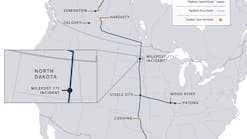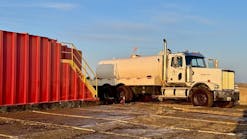SOTE pipeline rupture triggers one of Ecuador’s largest oil spills
On Mar. 13, 2025, a rupture occurred along a section of Ecuador’s state-owned Sistema de Oleoducto Transecuatoriano (SOTE) near El Vergel, releasing an estimated 25,116 bbl of crude oil, according to the Ministry of Energy. The incident impacted three rivers, nearly 300 hectares of agricultural land, and led to a 6-day suspension of crude transport operations.
Petroecuador declared force majeure and placed the SOTE under emergency status.
Preliminary investigations attributed the rupture to a landslide. Petroecuador confirmed the spill volume and reported the recovery of 30,257 bbl of crude-oil-and-water mixture. The operator allocated $4 million for initial emergency response efforts and deployed monitoring teams to assess damage in protected mangrove zones.
Crude transport through the pipeline resumed, and exports of Oriente crude restarted partially, though the force majeure declaration remained in effect.
The spill is one of the largest associated with SOTE since it entered service in 1972. Over its history, the pipeline has experienced at least 77 ruptures, collectively spilling an estimated 767,157 bbl of crude.
SOTE has a designed capacity of 360,000 b/d. In January 2025, it transported an average of 273,600 b/d, or 76% of its nominal capacity. Remaining crude volumes were handled by the country's second major pipeline, the Oleoducto de Crudos Pesados (OCP).
Days after the rupture, Energy Minister Inés Manzano suggested sabotage could not be ruled out, citing unconfirmed reports. She indicated the matter could be referred to the Attorney General’s office but provided no further details.
On Mar. 25, heavy rainfall triggered the collapse of a containment dike on the Caple River, exacerbating environmental response challenges. Petroecuador deployed seven additional containment booms along the Viche River and mobilized heavy machinery to remove crude-contaminated debris.
Containment and remediation activities extended to the Caple and Esmeraldas rivers, with absorbent materials applied at key points. Technical crews from Petroecuador and OCP coordinated response operations at Piquiucho port to safeguard the sensitive Esmeraldas River Estuary Wildlife Refuge.
Cleanup operations also continued along beaches in Las Palmas, Atacames, and Muisne.
Three surveillance vessels patrolled offshore zones, reporting no visible oil slicks. Aerial reconnaissance over the Esmeraldas River delta confirmed no hydrocarbon presence, indicating that deployed barriers and mitigation strategies were containing the spill.
Camilo Ciruzzi | South America Correspondent
Ciruzzi is a journalist based in the Argentine province of Río Negro. He has over 30 years of experience in radio and print media. Ciruzzi studied Communication Sciences at the University of Buenos Aires and specialized in energy, political economy, and finance.


